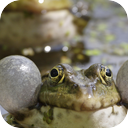(short preview of full seamless looping track)
Frogs In June
This product is not available in the selected currency.
In Stock
Backordered
Out of Stock
Description
The squeaky little sounds summoned from the swamp send bubbles bouncing along the surface of the water. You giggle at the scene and see hundreds of slimy eyes poke through the water's surface and then speedily spin away to the bottom, where darkness and silence serve as the perfect shield. There is nothing quite like the frogs in these parts. They create the only chorus that can sweetly send you to sleep at night. Many frogs contain mild toxins that make them unpalatable to potential predators. For example, all toads have large poison glands—the parotoid glands—located behind the eyes, on the top of the head. Some frogs, such as some poison dart frogs, are especially toxic. The chemical makeup of toxins in frogs varies from irritants to hallucinogens, convulsants, nerve poisons, and vasoconstrictors. Many predators of frogs have adapted to tolerate high levels of these poisons. Others, including humans, may be severely affected. Some frogs obtain poisons from the ants and other arthropods they eat; others, such as the Australian Corroboree Frogs, can manufacture an alkaloid not derived from their diet. Some native people of South America extract poison from the poison dart frogs and apply it to their darts for hunting, although few species are toxic enough to be used for this purpose. Because frog toxins are extraordinarily diverse, they have raised the interest of biochemists as a "natural pharmacy". The alkaloid epibatidine, a painkiller 200 times more potent than morphine, is found in some species of poison dart frogs. Other chemicals isolated from the skin of frogs may offer resistance to HIV infection.
This sound uses the following file from Freesound: http://www.freesound.org/samplesViewSingle.php?id=122055
Opps
Sorry, it looks like some products are not available in selected quantity.



